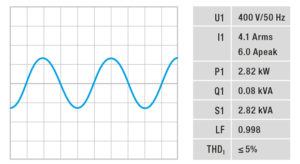
Bernhard Siedler, Team Leader Air Conditioning, ebm-papst Mulfingen (Foto: ebm-papst)
The need for data centers is growing worldwide, just like the quantities of data to be processed and the power density of the individual components. In spite of this trend, the average annual power consumption for air conditioning in data centers fell by eleven percentage points in the past ten years,
mainly due to the increased use of adjustable and efficient EC technology in fans.

Current waveform with passive PFC
ebm-papst series product:
Power factor (λ) = 0.94; THDI 33.5%
Modern motors are operated with variable frequency drives to exactly adjust their speed to requirements, which results in nonlinear currents. A non-sinusoidal current curve arises, which can be represented as a sum of sinusoidal curves with frequencies that are an exact multiple h of the fundamental frequency. This is total harmonic distortion (THDI), which is given in percent. A THDI of 33 percent means that in addition
to the 100 percent total active current, a 33 percent distortion reactive current is lost. The current harmonics also result in a heavy load on the supply network, disturbances, and high maintenance and replacement costs. So the aim is to minimize THDI. That is usually done with external passive or active filters that are barely able to reach a single-digit THDI value even with very high development and validation costs. They also involve other disadvantages such as space requirements, high system complexity, or high procurement costs. The best approach is to prevent harmonics from arising in the first place.

Current waveform with active PFC
New ebm-papst product:
Power factor (λ) = 0.99; THDI ≤ 5%
To do so, we developed the integrated 3-phase active PFC solution. “Active rectification” causes the input current to be sinusoidal instead of pulsed, with the current curve shifted so that the current level and voltage are in phase. The power factor is an important parameter, describing the ratio between effective power and apparent power. A value of = 1 is considered optimum. By filtering the harmonics, the 3-phase electronics with active PFC in the RadiCal and RadiPac series of EC centrifugal fans reach = 0.99 and a THDI value of less than five percent. Compared with the industry standard, active PFC technology reduces the costs for the required energy supply components by about 38 percent.

Leave a comment